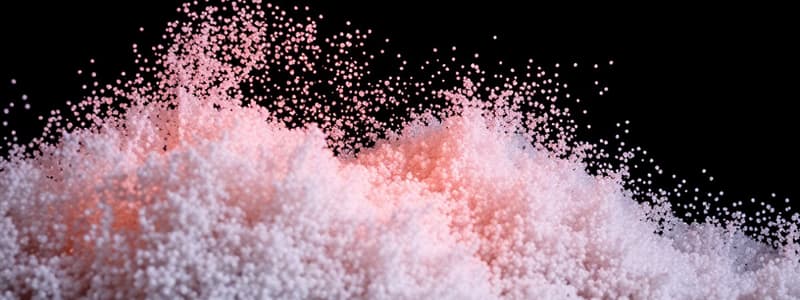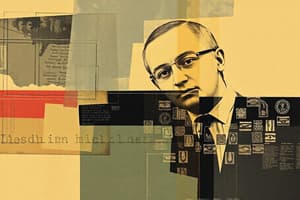Podcast
Questions and Answers
Which strategy involves directing marketing efforts towards channel members to encourage their cooperation in stocking products?
Which strategy involves directing marketing efforts towards channel members to encourage their cooperation in stocking products?
- Neutral Strategy
- Pull Strategy
- Push Strategy (correct)
- Indirect Strategy
When is a push strategy most appropriate?
When is a push strategy most appropriate?
- When consumers perceive brand differences
- When brand loyalty is high
- When brand choice is made in the store (correct)
- When there is a high category involvement
What does a pull strategy emphasize?
What does a pull strategy emphasize?
- Trade promotions
- Direct mail marketing
- Advertising and consumer promotions (correct)
- Personal selling
In which scenario is a pull strategy typically more effective?
In which scenario is a pull strategy typically more effective?
What is a key difference that online channels introduce compared to offline channels?
What is a key difference that online channels introduce compared to offline channels?
Which of the following is an advantage offered by physical stores that online channels typically cannot replicate?
Which of the following is an advantage offered by physical stores that online channels typically cannot replicate?
Which of the following describes a benefit of physical stores?
Which of the following describes a benefit of physical stores?
What is one potential downside of online channels for retailers?
What is one potential downside of online channels for retailers?
What is the primary role of distribution in the context of manufacturers and consumers?
What is the primary role of distribution in the context of manufacturers and consumers?
Which of the following is NOT a key element of effective distribution?
Which of the following is NOT a key element of effective distribution?
Why are channel decisions considered 'sticky'?
Why are channel decisions considered 'sticky'?
What is a potential benefit of a superior channel strategy?
What is a potential benefit of a superior channel strategy?
Which of the following is an objective of channel management?
Which of the following is an objective of channel management?
What is the primary role of a distribution channel?
What is the primary role of a distribution channel?
Which of the following is considered a channel intermediary?
Which of the following is considered a channel intermediary?
A direct distribution channel involves:
A direct distribution channel involves:
What is a key decision when setting up distribution channels?
What is a key decision when setting up distribution channels?
Which type of distribution channel involves intermediaries?
Which type of distribution channel involves intermediaries?
In the context of distribution, 'breadth' refers to:
In the context of distribution, 'breadth' refers to:
A set of firms or individuals who participate in the flow of products from manufacturers to customers are known as:
A set of firms or individuals who participate in the flow of products from manufacturers to customers are known as:
What may be more effective than discounting and advertising at increasing sales of new brands?
What may be more effective than discounting and advertising at increasing sales of new brands?
What is the function of channel members?
What is the function of channel members?
What must distribution channels reinforce?
What must distribution channels reinforce?
Which type of intermediary takes title to the goods but is not tied to any specific company?
Which type of intermediary takes title to the goods but is not tied to any specific company?
Which of the following does NOT take title to the products they sell?
Which of the following does NOT take title to the products they sell?
What is the primary characteristic of a captive distributor?
What is the primary characteristic of a captive distributor?
What is the key difference between an agent and a broker?
What is the key difference between an agent and a broker?
What is a direct channel?
What is a direct channel?
What is the main focus of the 'horizontal structure' in distribution channels?
What is the main focus of the 'horizontal structure' in distribution channels?
What is the primary goal of intensive distribution?
What is the primary goal of intensive distribution?
In selective distribution, how many intermediaries are used?
In selective distribution, how many intermediaries are used?
What is the defining characteristic of exclusive distribution?
What is the defining characteristic of exclusive distribution?
Why might a company choose exclusive distribution?
Why might a company choose exclusive distribution?
What is a key factor that makes customers willing to dedicate time for dedicated sales meetings?
What is a key factor that makes customers willing to dedicate time for dedicated sales meetings?
When is it better to go direct to the consumer?
When is it better to go direct to the consumer?
What is the strategy of controlling more of your product's supply chain called?
What is the strategy of controlling more of your product's supply chain called?
What is an example of vertical control in distribution channels?
What is an example of vertical control in distribution channels?
Which type of channel conflict occurs between different levels of the same channel?
Which type of channel conflict occurs between different levels of the same channel?
Which type of channel conflict occurs among firms at the same level of the same channel?
Which type of channel conflict occurs among firms at the same level of the same channel?
What is a typical point of conflict between a manufacturer and a distributor?
What is a typical point of conflict between a manufacturer and a distributor?
What is the term for conflicts that arise when a manufacturer sells directly to customers online, competing with its existing retailers?
What is the term for conflicts that arise when a manufacturer sells directly to customers online, competing with its existing retailers?
In channel conflicts, what do manufacturers often request from distributors regarding new products?
In channel conflicts, what do manufacturers often request from distributors regarding new products?
What do distributors typically want from manufacturers regarding territories?
What do distributors typically want from manufacturers regarding territories?
Flashcards
Push Strategy
Push Strategy
A strategy where marketing efforts are directed at channel members to encourage them to stock and sell a product.
Pull Strategy
Pull Strategy
A strategy where marketing efforts are directed at end consumers to create demand that 'pulls' the product through the channel.
When to use a Push Strategy
When to use a Push Strategy
A marketing strategy suitable for products with low brand loyalty, where decisions are made in-store, and purchases are often impulsive.
When to use a Pull Strategy
When to use a Pull Strategy
Signup and view all the flashcards
How online is different
How online is different
Signup and view all the flashcards
What physical stores offer
What physical stores offer
Signup and view all the flashcards
Transparency online
Transparency online
Signup and view all the flashcards
Physical store benefits
Physical store benefits
Signup and view all the flashcards
Distribution Importance
Distribution Importance
Signup and view all the flashcards
Distribution Channel
Distribution Channel
Signup and view all the flashcards
Distribution System Structure
Distribution System Structure
Signup and view all the flashcards
Direct Channel
Direct Channel
Signup and view all the flashcards
Indirect Channel
Indirect Channel
Signup and view all the flashcards
Effectiveness of Distribution Strategy
Effectiveness of Distribution Strategy
Signup and view all the flashcards
Distribution Definition
Distribution Definition
Signup and view all the flashcards
Distribution (Place)
Distribution (Place)
Signup and view all the flashcards
Channel Margin Importance
Channel Margin Importance
Signup and view all the flashcards
Channel Management Objectives
Channel Management Objectives
Signup and view all the flashcards
Sticky Channel Decisions
Sticky Channel Decisions
Signup and view all the flashcards
Direct Sales Force
Direct Sales Force
Signup and view all the flashcards
Captive/Sole Distributors
Captive/Sole Distributors
Signup and view all the flashcards
Wholesalers
Wholesalers
Signup and view all the flashcards
Manufacturer's Representative (Agent)
Manufacturer's Representative (Agent)
Signup and view all the flashcards
Brokers
Brokers
Signup and view all the flashcards
Retailers/Dealers
Retailers/Dealers
Signup and view all the flashcards
Intensive Distribution
Intensive Distribution
Signup and view all the flashcards
Selective Distribution
Selective Distribution
Signup and view all the flashcards
Dedicated Sales Meeting
Dedicated Sales Meeting
Signup and view all the flashcards
Vertical Integration
Vertical Integration
Signup and view all the flashcards
Channel Conflict
Channel Conflict
Signup and view all the flashcards
Horizontal Channel Conflict
Horizontal Channel Conflict
Signup and view all the flashcards
Vertical Channel Conflict
Vertical Channel Conflict
Signup and view all the flashcards
Multichannel Conflict
Multichannel Conflict
Signup and view all the flashcards
Manufacturer's Perspective (Channel Conflict)
Manufacturer's Perspective (Channel Conflict)
Signup and view all the flashcards
Distributor's Perspective (Channel Conflict)
Distributor's Perspective (Channel Conflict)
Signup and view all the flashcards
Direct Sales Impact
Direct Sales Impact
Signup and view all the flashcards
Multichannel Conflicts
Multichannel Conflicts
Signup and view all the flashcards
Study Notes
- VO Management I - Marketing (MA) is covered during week 4 focusing on distribution channels.
- The course is led by Univ.-Prof. Dr. Christoph Fuchs, Chair of Marketing.
- Marketing plan includes product, price, promotion, and place.
- Marketing strategy includes segmentation, targeting, and positioning.
- Marketing prerequisites include marketing research and consumer behavior.
Definition of Distribution
- Distribution involves all stakeholders which can be persons or organizations.
- They create a revenue stream between a manufacturer and a consumer.
What is Distribution?
- Making goods/services at the right time and location.
- Goods should be available in the correct quantity and to the right customer.
- The distribution should be better than the competitors'.
Channel Management
- Channel members collectively earn 30-50% of the selling price in the U.S.
- Channel choices include long-term structure.
- A superior channel strategy can provide competitive advantages.
- Retailers are changing due to being online.
Channel Management Objectives
- Reduction of distribution costs
- Image of the channel
- Improvement of cooperation and steering of channels
- Flexibility and time to market
Importance of Distribution
- Distribution breadth plays the largest role in the success of new brands
- Distribution increases sales more than discounting, advertising, and features/displays.
- Distribution interacts with other strategies, increasing effectiveness, and must reinforce overall strategy.
Channels
- A distribution channel is a set of firms or individuals participating in the transfer of products from manufacturers to customers.
- These firms/individuals are referred to as channel intermediaries.
Channel Decisions
- The first decision for a channel is the structure of the distribution system, beginning with vertical structure.
- Vertical structure can either contain direct channels or indirect channels.
- The second decision is horizontal Structure of Distribution.
- The horizontal structure contains intensity, type of intermediate, intensive, selective, exclusive distribution, and the length of the distribution.
Channel Members and Function
- Direct Sales Force: The channel members keep title, work for you, direct control, only company products.
- Distributors: Captive or sole distributors, intermediaries take title and only work for you.
- Wholesalers: Take title but are not tied to any company.
- Agents: Manufacturer's representatives who don't take title and work for you and others.
- Brokers: They are free agents without title or ties to manufacturers.
- Retailers/Dealers: They mainly don't work for you, usually take title.
Levels of Distribution Intensity
- Intensive: Includes all intermediaries willing to stock and sell Coke.
- Selective: When only some intermediaries stock and sell them.
- Exclusive: When severely limiting intermediaries.
Taiwan Tea Distribution
- 20,000 tea farmers in the hills of Taiwan go through 280 middlemen before reaching 60 refineries.
- Tea middlemen bought low and sold high, which gave them a bad reputation among farmers and refineries.
- Government set up a tea auction house in 1923 near the refineries to counter the middlemen's power.
- The farmers could now ship directly to the auction house, where the tea would be bought by the highest bidder.
Role of the Middleman
- Facilitating searches for high quality teas, taking samples to refineries, and asking for purchase orders.
- Sorting of different species of tea.
- Contact efficiency to get the best price, without middlemen: 20k famers X 60 refineries = 1.2M contacts.
- Intermediaries can streamline a transaction. Functions of Distribution Channel
- Overcoming discrepancies
- Manufacturers make narrow assortments but customers want wide assortments.
- Distribution has contact efficiency since they are specialized.
- Physical distribution including transportation.
- Inventory risk reduction by warehousing.
- The channel handles sales and returns.
- Distribution provides service before and after sales.
- Channels gather information/market feedback up and down the channel.
Disintermediation
- Direct selling is not suitable for every product.
- Disintermediation (trend towards direct selling) works when;
- Manufacturing direct contacts are relatively small.
- There are a small number of customers.
- The products have large orders.
- Low order frequency.
- When important customers want high product customization or require lots of information.
Verticalization of Distribution Channels and Control
- This is when a manufacturer starts taking over the tasks of a distributor such as opening their own stores or online channels.
Channel Conflicts
- Vertical conflicts
- Horizontal conflicts
- Multichannel conflicts
Channel Tactics
- Push strategies are directing marketing efforts into channels to generate cooperation, used when there is low brand loyalty and customers purchase on impulse
- Pull strategies which include marketing to end consumers, are leveraged to improve cooperation, and is best for products with high brand loyalty, and high category involvement.
Online Channels
Different from the traditional methods in transparency, availability, pricing, customized rates to customers,. and reduction in impulse buying.
- Physical stores provide consumers the ability to touch/feel/see the product before purchasing, and provide information, immediate availability, entertainment, a location to pick up larger items, and services from those stores
Effect of Distribution Channel on Customers
- Consumers are willing to pay 73% more at the fancy resort relative to a run-down grocery store.
- Distribution expectations matter and can shape consumer expectations.
- Value is consistent for consumers.
Key Takeaways
- Distribution is the hardest marketing mix element to change.
- Channels can be a source of competitive advantage
- A distribution channel serves important functions; it is not just an additional cost.
- Manufacturers balances push and pull strategies
- Exclusive distribution leads to greater focus and customer service.
- Direct sales aligns incentives but adds cost
- Channels should be based on STP!
Studying That Suits You
Use AI to generate personalized quizzes and flashcards to suit your learning preferences.



